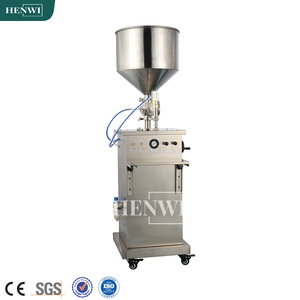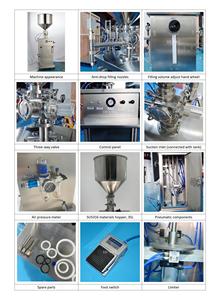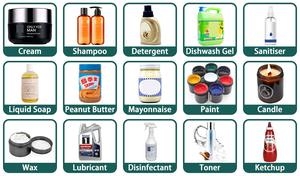
All categories
Featured selections
Trade Assurance
Buyer Central
Help Center
Get the app
Become a supplier

(39684 products available)




















A honey bottle filling machine comes in different specialized variations for filling viscous liquids like honey, which crawl or drip products. They are typically manufactured to cater to the specific needs of an industry in terms of speed, accuracy, and automation. This machine is available in three major types: rotary, inline, and intermittent.
Rotary honey filling machines
Like a carousel, the rotary machine features several filling heads situated on a revolving disc or seal where containers or bottles are also placed. As the rotary machine spins in a clockwise direction, each container on the disc is successively brought under a filling head. When the honey fills the container, the capping device applies a cap to it. The disc then rotates to bring the filled container to the next station or location.
Due to the succession of operations in a single cycle of revolution, rotary filling machines have very high productivity. Honey is filled in containers at a high rate. These machines are often used for mass production. Industries such as the beverage or food industry use rotary honey filling machines because they have high production lines and need to fill containers successively within a short time.
Rotary honey filling machines are ideal for constant production lines. They are extremely efficient and accurate. In fact, they have an average accuracy rate of about 98–99%. The disc and the multiple filling heads make this machine also have:
However, this machine requires a higher initial cost during purchase, and operators must be trained to understand how to use it.
Inline honey filling machines
This machine is the opposite of a rotary filling machine. Here, the filling nozzles are in an inline position. Containers that are to be filled are placed in front of the nozzles, and honey is filled through the inline nozzles into these containers.
Inline honey filling machines are generally less expensive than rotary filling machines. Because inline filling machines have just one horizontal line of filling nozzles, they are easier to clean and maintain. Their capping and filling processes are also uncomplicated.
Inline honey filling machines offer operators control since the filling speed can be adjusted based on the situation and honey viscosity. Although they are on the less costly side, inline filling machines also have great accuracy (about 98%) and are fast.
The major downside is that inline honey filling machines require manual operations, which can eventually cause honey spills.
Intermittent filling machines
As the name implies, this filling machine will fill honey intermittently rather than continuously. The filling head hovers over a container, and honey is filled after a certain time period has passed. The container might be moved under the nozzle again, and the process of filling will repeat by releasing a set volume of honey.
Intermittent filling machines have many benefits. For one, they are more affordable than many filling machines for viscous liquids. Because of their cost benefit, some small-scale businesses in the food, chemical, and agricultural industries use this machine to fill honey in varying container sizes.
Intermittent honey filling machines offer more customization options than others. Different filling nozzles can be attached for greater precision. Though they take a longer time to fill a certain number of containers, intermittent filling machines are quite easy to operate. Their maintenance and cleaning processes are also very straightforward.
On the downside, an intermittent filling machine will not fill containers at a high rate. It might hold up production lines when more speed and efficiency are needed. They are also less accurate than inline or rotary filling machines, with an average accuracy of about 94%.
The following are general specifications for bottle filling machines. They may vary depending on the specific type and model of the machine.
Regular maintenance keeps the bottle filling machine working smoothly and prevents untimely breakdowns. Here are a few maintenance tips.
The honey bottle filling machine can be used in various scenarios to meet the needs of different industries.
Food and Beverage Industry
Factories that produce honey, syrup, juice, and other liquids use honey bottle filling machines to fill and package their products. These machines improve production efficiency, maintain product quality, and meet packaging standards.
Wholesalers and Distributors
Honey bottle filling machines are used by wholesalers and distributors to fill and package various liquids for sale. They handle multiple products, such as beverages, condiments, cleaning supplies, and more. Using these machines allows for efficient filling and packaging, saving time and labor costs.
Small-scale Production
Small-scale farms, workshops, or homemade food production sites can also benefit from honey bottle filling machines. Compact or semi-automated models are suitable for this use. They can fill bottles with honey, jams, sauces, and other homemade products. These machines help improve filling accuracy and efficiency, meeting individual customer needs.
Wholesale buyers need to consider several factors of the honey bottle filling machines when selecting the fit for their production line and business.
Consider Various Filling Machines
It's essential to consider the honey bottle filling machine's type, operation, capacity, and accuracy. Choose a machine that is in line with the production needs and can handle the viscosity of honey. Also, assess its ability to fill various bottle shapes and sizes.
Flexibility and Scalability
When choosing a honey bottle filling machine, it's important to consider flexibility and scalability. The machine's ability to adapt to new bottle sizes, formulations, and production processes is crucial. Scalability ensures that the filling machine can accommodate future expansion requirements. For instance, the easy changeover of filling heads and nozzles allows for the quick adjustment of different bottle sizes.
Machine Efficiency
Consider the machine's overall efficiency, encompassing speed, accuracy, and ease of operation. Choose machines with development fastness and efficient filling techniques to enhance production output. Investigate the machine's automation level and usability, as well as its maintenance needs. The machine's dependability and durability should also be considered, as constant performance is necessary to achieve production goals.
Safety Features
Consider the filling machine's safety features. Look for machines with overload protection, emergency stop buttons, and safety guarding to prevent operator injury and equipment damage.
Q1: Is it better to bottle honey in plastic or glass?
A1: Glass honey bottles are recyclable, and bees keepers prefer them because they create a perception of quality. Plastic honey bottles, on the other hand, are lightweight and less breakable.
Q2: What are the latest trends in honey bottling?
A2: Sustainable packaging is an emerging trend in the honey industry. Many business are now using materials such as glass and biodegradable plastic. Importantly, these materials not only offer product protection but also minimize environmental impact.
Q3:What is the role of labeling in honey bottling?
A3: Labeling not only provides the necessary information about the products but also serves as a marketing tool to attract customer attention and build brand recognition.
Q4: What is the capacity of honey bottle filling machines?
A4: The capacity of a honey bottle filling machine depends on its type. For example, manual machines are suitable for small-scale production because operators can fill 30 to 50 bottles per day. On the other hand, semi-automatic machines are ideal for medium-scale production with an average of 100 to 500 honey bottles per day. Finally, fully automatic machines are recommended for large scale production, with the ability to fill more than 500 bottles in a single hour.